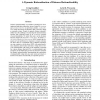14 search results - page 1 / 3 » Social Distances Model of Pedestrian Dynamics |
ACRI
2006
Springer
13 years 11 months ago
2006
Springer
Abstract. The knowledge of phenomena connected with pedestrian dynamics is desired in the process of developing public facilities. Nowadays, there is a necessity of creating variou...
IAT
2010
IEEE
13 years 3 months ago
2010
IEEE
Group modeling is still an open challenge problem in pedestrian crowd simulations. Most existing work is based on socio-psychological models which can only describe the dynamics o...
CHI
2010
ACM
14 years 4 days ago
2010
ACM
We describe a virtual “tether” for mobile devices that allows groups to have quick, simple and privacy-preserving meetups. Our design provides cues which allow dynamic coordin...
AAAI
2012
11 years 7 months ago
2012
Distance rationalizability is an intuitive paradigm for developing and studying voting rules: given a notion of consensus and a distance function on preference profiles, a ration...
ICRA
2010
IEEE
13 years 3 months ago
2010
IEEE
Abstract— For many tasks in populated environments, robots need to keep track of present and future motion states of people. Most approaches to people tracking make weak assumpti...

